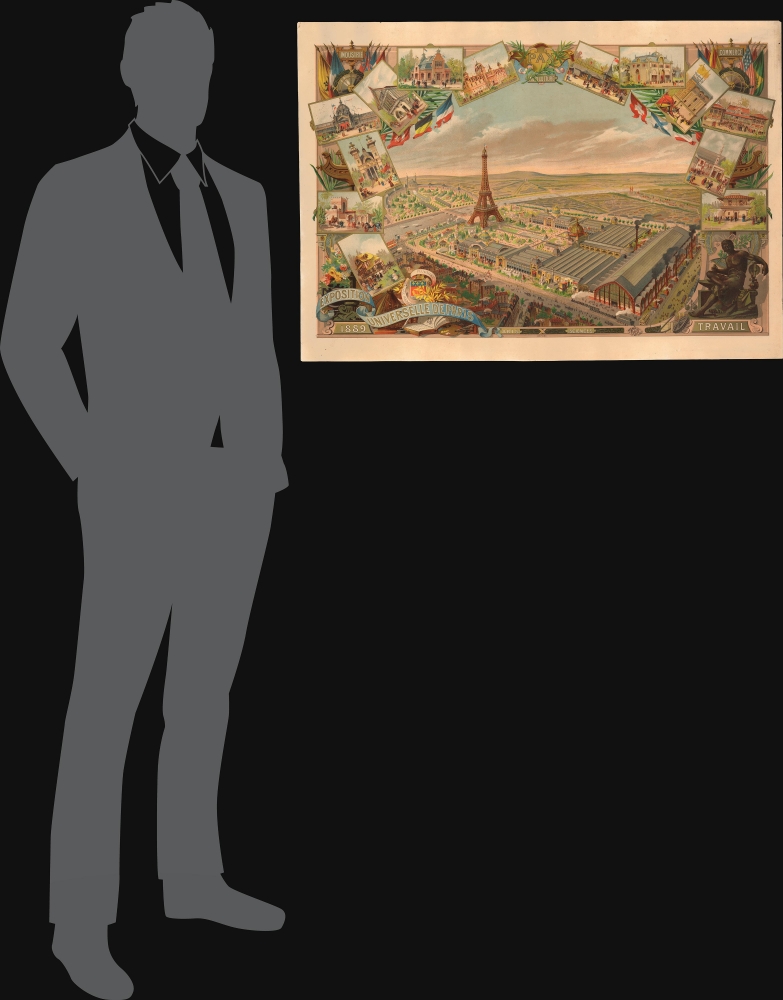1889 GTC Exposition Universelle View of Paris w/ the Eiffel Tower
ExpoUniverselleParis-gibertclarey-1889
Title
1889 (dated) 22.25 x 34.5 in (56.515 x 87.63 cm)
Description
A Closer Look
The newly constructed Eiffel Tower, then the world's tallest building, dominates the image. Surrounding it are the fairground's many pavilions and exhibition halls. Visitors roam the fairgrounds and appreciate the Palais du Trocadero and awe at the newest architectural, technological, and scientific marvels. Trains, streetcars, and carriages provide transportation but are themselves technological marvels. Vignettes resembling postcards surround the central view, promoting exhibits, including the 'Rue de Caire', the Central Pavilion, and the structures dedicated to promoting some of the international participants: Brazil, Bolivia, Arabia, and the French colonies of Annam and Tonkin (Vietnam).1889 Exposition Universelle
Held in Paris, France, from May 5 through October 31, 1889, the Exposition was the fourth World's Fair held in Paris. It witnessed the unveiling of the Eiffel Tower, which was, then as now, a marvel of engineering. The fair welcomed over 32,000,000 visitors and took place on the Champ de Mars, the parade ground in front of the École Militaire. Other notable structures include the Gallery of Machines, a hall dedicated to science and technology (where some of Thomas Edison's most recent inventions were exhibited), and the Palaces of Liberal Arts and Fine Arts. One of the more popular attractions was the 'Street of Cairo' ('Rue de Caire') which recreated the architecture and street life of Cairo, Egypt.Chromolithography
Chromolithography, sometimes called oleography, is a color lithographic technique developed in the mid-19th century. The process involved using multiple lithographic stones, one for each color, to yield a rich composite effect. Oftentimes, the process would start with a black basecoat upon which subsequent colors were layered. Some chromolithographs used 30 or more separate lithographic stones to achieve the desired product. Chromolithograph color could also be effectively blended for even more dramatic results. The process became extremely popular in the late 19th and early 20th centuries when it emerged as the dominant method of color printing. The vivid color of chromolithography made it exceptional for advertising and propaganda imagery.Publication History and Census
This broadside was designed, engraved, and published by Gibert-Clarey of Touris to promote the 1889 Paris Exposition Universelle. We note an example in the collection of the Universitäts- und Landesbibliothek Darmstadt. We have found only a handful of other instances when examples have appeared on the private market.Cartographer
Gibert-Clarey (1873 - Present) was a French printing house active in Tours during the mid to late 19th century. In 1863, Jean-Baptiste Gibert (Vallères, Indre-et-Loire; June 24, 1832 - April 22, 1902) married Constance Clarey, daughter of the Tours booksellers and lithographers Pierre Clarey and Jeanne Martineau. Clarey and Martineau, who published as Clarey-Martineau, retired in 1865, leaving the business in the hands of their son, Alfred Célestin Clarey (Tours, Indre-et-Loire; October 9, 1838 - February 11, 1907), and son-in-law, Gibert. Jeanne Clarey, for some reason, retained the Tours lithographer's patent and did not transfer it to her son. This is likely why, in 1873, Gibert and Carey founded 'Clarey-Martineau and Gibert', opening a sales office in Paris. This iteration of the business was dissolved in 1876 when Clarey relocated to Ansières while Gibert remained active in Tours as 'Imprimerie Gibert-Clarey.' He specialized in vivid chromolithographic advertising cards, labels, and broadsides, with work often unsigned or signed simply as GTC. Their work won a bronze medal at the Exhibition of Applied Arts in Industry in 1876 and a first prize and silver-gilt medal at the Angers Exhibition in 1877. When Gibert died, the firm was taken over briefly by his widow, then by his son, René Gibert, who expanded into typography. The firm, remarkably, remains active as Gibert-Clarey Imprimeurs. More by this mapmaker...




